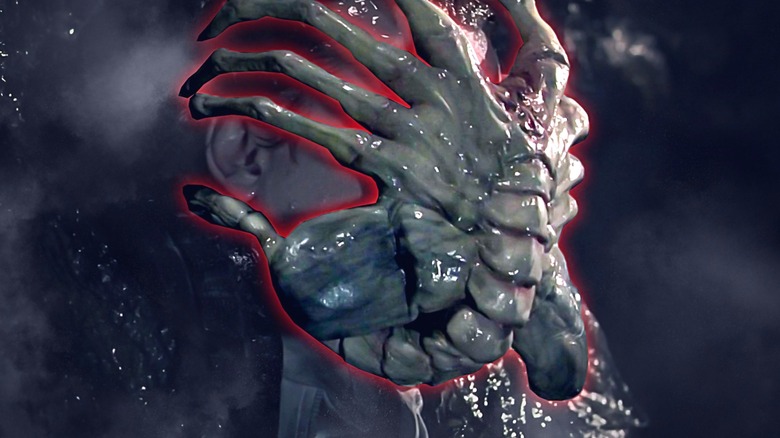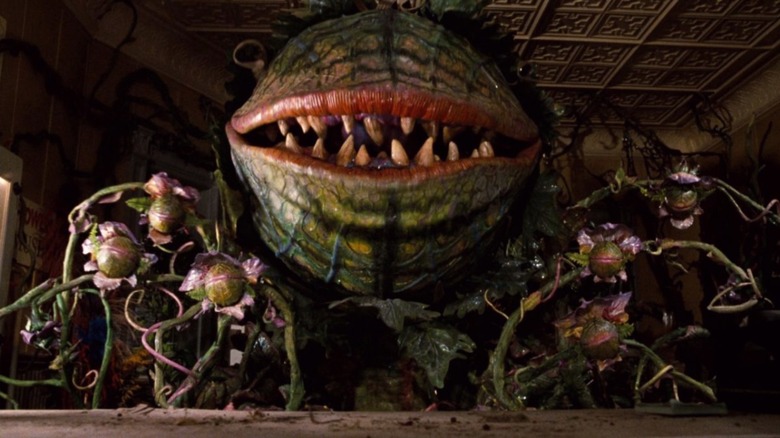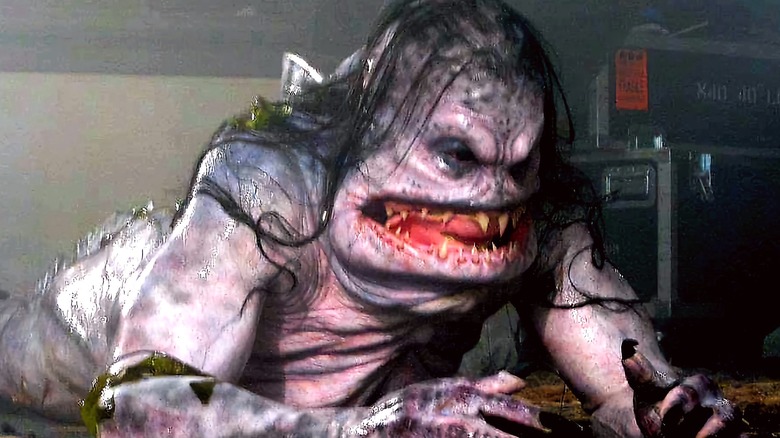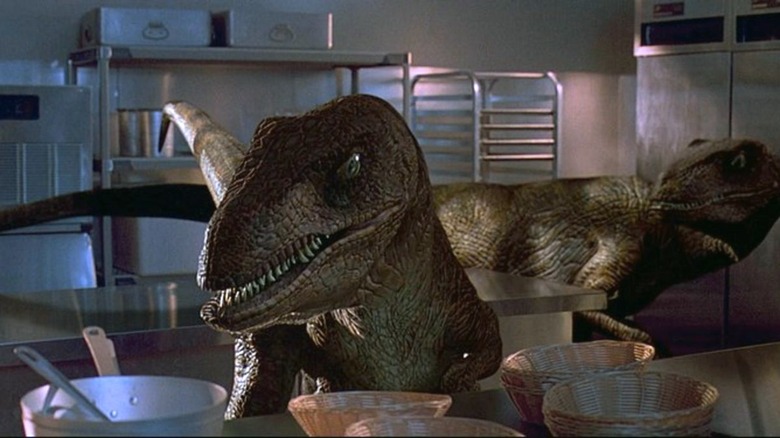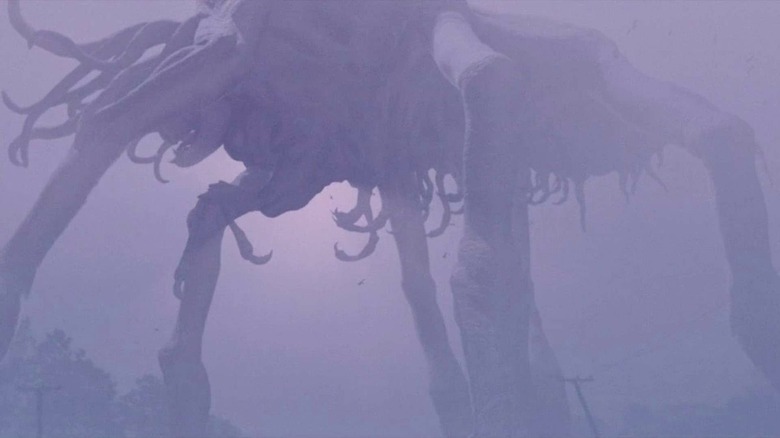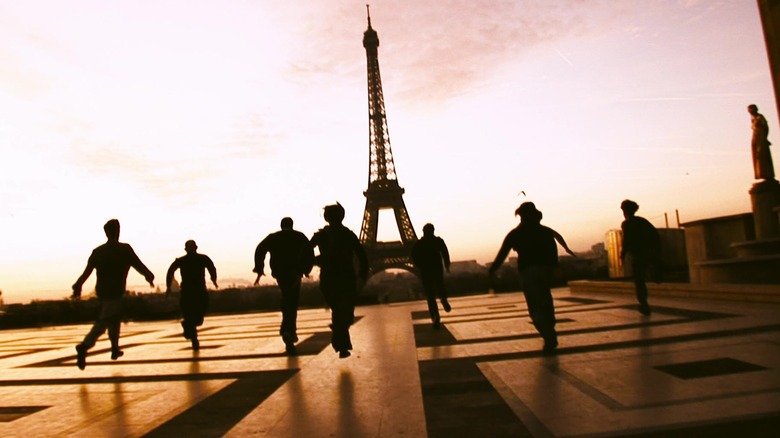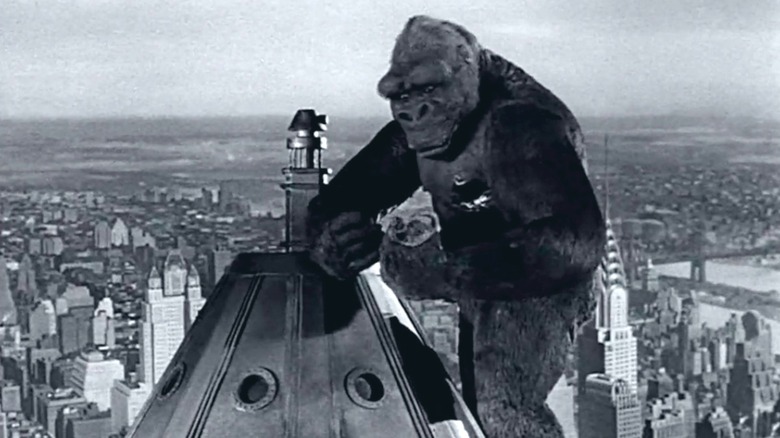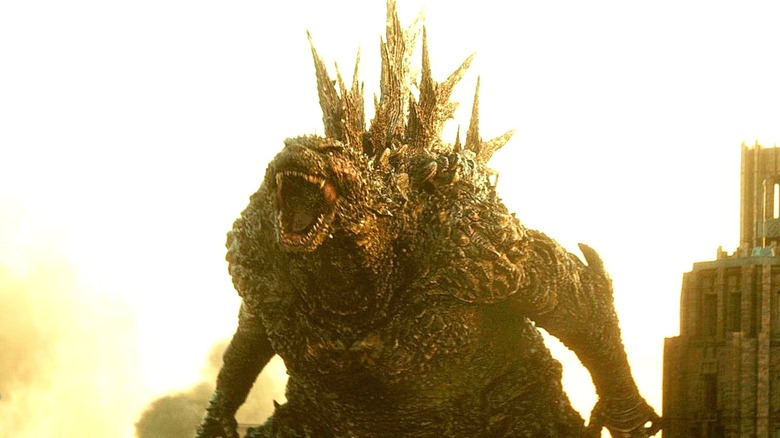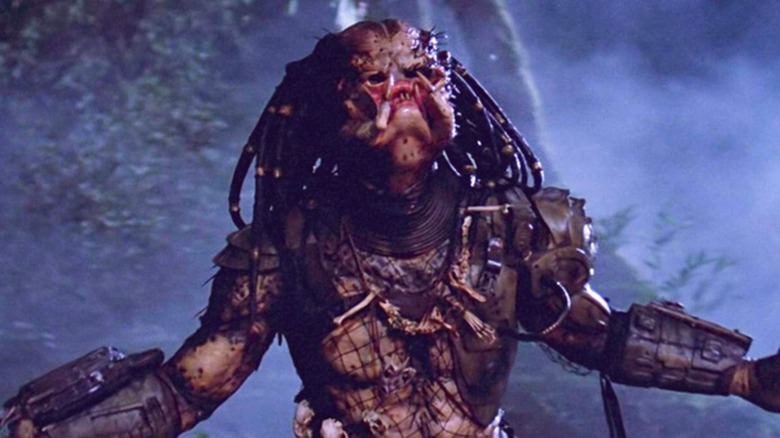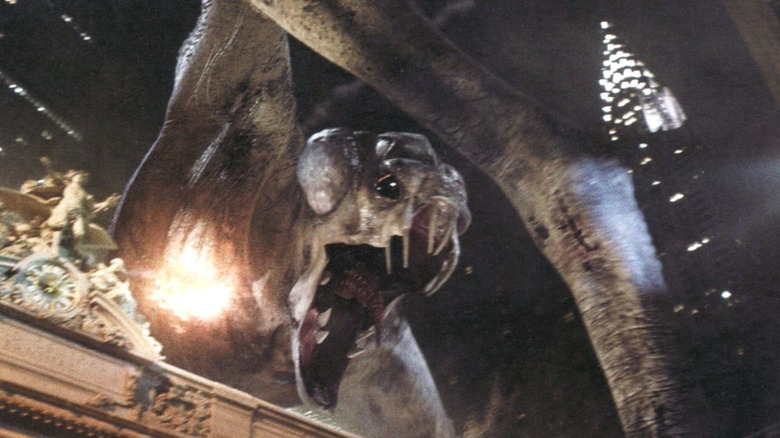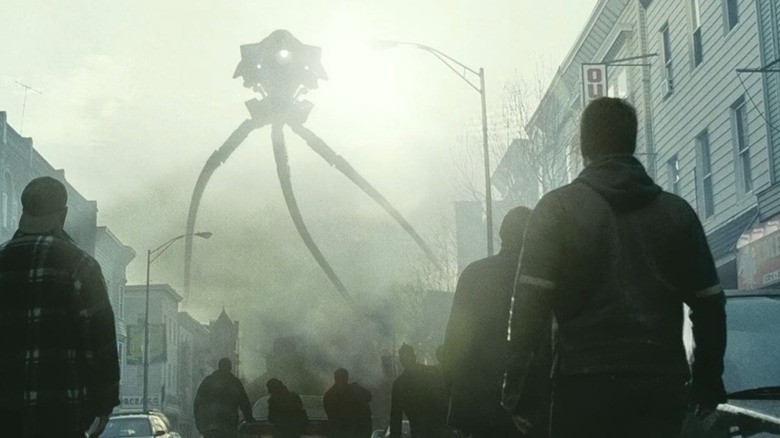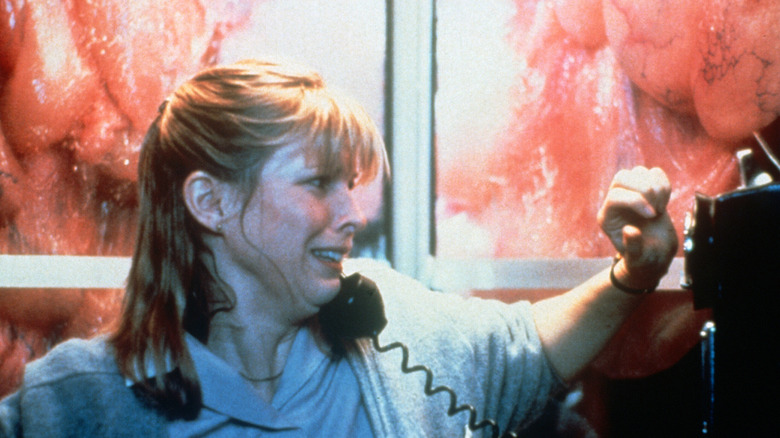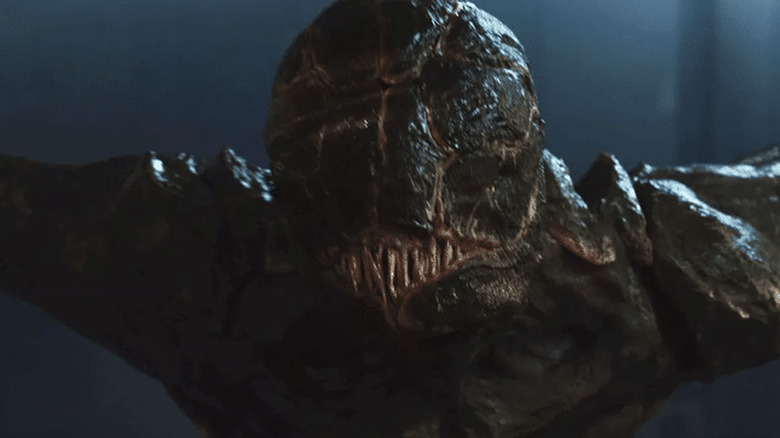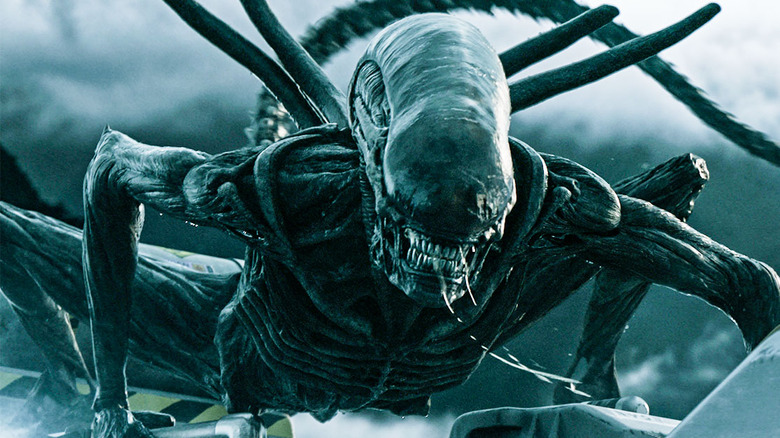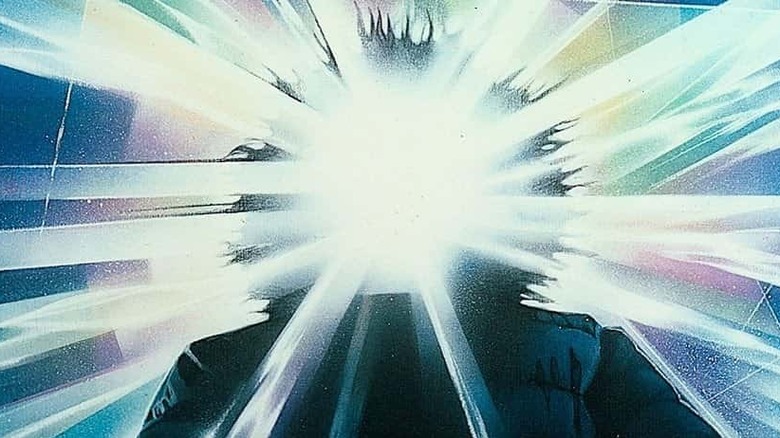Sci-Fi Monsters That Are Scarier Than Facehuggers
While horror movies feature some of cinema's nastiest creatures, monsters, and psychopaths, it's not the only genre with frightening things. Science fiction isn't always about cute aliens phoning home or adorable robots saving humanity — many science fiction movies delve into horror by showing all kinds of alien and supernatural creatures and horrific outcomes from flying out into the deepest, darkest reaches of outer space.
Many sci-fi creatures are creepy or downright horrifying — and the facehugger is the poster child of scary sci-fi movie monsters. Their spiderlike appendages and slimy coating make them physically repulsive, while the way they impregnate victims with their spawn by latching onto their faces is disturbing in more ways than one. Facehuggers plant alien embryos inside their victims, and once the aliens have matured inside of them, they burst out of their chests. It's maybe one of the worst ways to go in all of sci-fi.
Ultimately, though, the facehugger is only one aspect of Xenomorph biology — there's far scarier stuff out there. These are the most frightening monsters from sci-fi that instilled fear in audiences going back to the earliest days of the medium. Each one has something scary to offer, and odds are, one of these nasty buggers is going to keep you up at night.
Audrey II from Little Shop of Horrors
"Little Shop of Horrors" is a musical comedy about Seymour Krelborn (Rick Moranis), a flower shop employee in love with his co-worker, Audrey (Ellen Greene). Seymour's life changes for the better after a total eclipse of the sun drops a small, Venus flytrap-like plant in his path. Seymour names the plant (voiced by Levi Stubbs) Audrey II, and while it's initially adorable, it doesn't take long for Audrey II to grow into a massive monster.
Despite the music numbers and film's general campy tone, the danger posed by Audrey II is high-stakes, as the plant is a self-described "Mean Green Mother from Outer Space" intent on world domination! Seymour manages to stop Audrey II's propagation by electrocuting the plant to death, but it's a pretty close call.
There are two endings to the film, and in the original ending, Audrey II's domination comes to pass. The theatrical cut changed this to make it more lighthearted, but it doesn't make Audrey II any less frightening. The plant literally eats people, growing larger with each bite, and it's capable of sprouting equally lethal buds.
The Merman from Cabin in the Woods
"Cabin in the Woods" is unusual in that it includes science fiction elements while also delving into just about every horror monster that's ever terrified an audience. A group of college students attempt to blow off some steam vacationing at a cabin in the woods. Unbeknownst to them, the cabin is an elaborate trap designed to capture unwilling sacrifices to sate subterranean elder gods intent on destroying the world.
Before any of that can happen, the students trigger various creatures that come after them, beginning with a redneck zombie torture family. Throughout the action, engineers in an underground lab take bets on how the students will die, and one of them (Bradley Whitford) is desperate to see the Merman take them out.
He's disappointed, but eventually, all the monsters escape their enclosures, including the Merman, and it's insanely grotesque. Forget Ariel or any other mermaid you know — this guy is a nasty, fishlike creature with a massive, gaping maw. The unfortunate engineer gets his wish to see the Merman, but ends up on his menu instead. He goes neither quietly or quickly, and the Merman ejects blood from its blowhole as it feasts on his body. It's one of the craziest deaths in "Cabin in the Woods," and the Merman is one of the nastiest monsters in the film.
Velociraptors from the Jurassic Park franchise
True, the Velociraptors in "Jurassic Park" aren't much like the prehistoric creatures that inspired them. In the films, they're presented as intelligent, highly motivated pack animals intent on killing and eating whatever they can. This includes some kids, a few scientists, and a computer engineer or two. The thing that makes the Velociraptors in "Jurassic Park" so scary is their intelligence, because they demonstrate sophisticated pack coordination and problem-solving skills throughout every film in the franchise.
In the first film, the Velociraptors open doors and communicate with one another to surround prey. Raptors have incredibly sharp teeth, powerful jaws, and a special claw used to tear flesh, so they've earned their killer reputation — as Alan Grant (Sam Neill) warns in the film, they'll start eating you while you're still alive. Later films continue adding horrifying traits to the raptors — in "The Lost World: Jurassic Park," the raptors assault the group as they move through a field of tall grass, camouflaging the Velociraptors while they drag their helpless prey to the dirt. In "Jurassic Park III," the raptors use one of the survivors as live bait to draw the others out. A mean, scaly killing machine is bad enough, but one that can open doors, track prey, and set traps? Terrifying.
The Mist and all the monsters from The Mist
"The Mist" focuses on the small town of Bridgton, Maine, where a storm brings in an unusually thick foglike mist. The mist blankets the town as residents hole up in a supermarket, where they watch as deadly creatures emerge, dragging victims into the mist or outright eating them in front of horrified onlookers. For much of the film, a group of survivors remains encamped in the store, watching with horror as an unimaginable nightmare unfolds outside.
Eventually, as more dangerous and massive creatures appear, a small group of survivors flee in a car. Unfortunately for them, they find that the mist has seemingly enveloped the world, and no matter where they go, they're on the menu for some horrific creature from another dimension. Their hopeless journey into the mist — and the terrible things that happen next — make for some of the most disturbing moments in "The Mist."
While the creatures themselves are ghastly and terrifying, the scariest thing about the story is the mist itself. Its otherworldly nature and ominous presence foretell nothing but doom, making the survivors' situation appear hopeless. It's scary, and it's definitely made more than a few viewers side-eye any clouds of mist that roll in on them. You never know what terrors might be hiding within the mist.
The Infected from 28 Days Later and 28 Weeks Later
In "28 Days Later," an engineered virus called the "rage virus" escapes a laboratory, quickly infecting all of Great Britain. The rage virus is highly contagious, and its effects are almost instantaneous. Anyone infected loses their sanity, becomes intensely enraged, and wants to kill anyone who is uninfected. The infected are much like zombies, but they're not undead.
These aren't your grandpa's zombies. The infected are terrifying and ruthless, sprinting after and tearing apart their victims. They use anything from blunt weapons to their teeth — they use whatever they can find to kill, and they're highly efficient. What makes the infected more frightening than zombies is that they can still reason somewhat, showing signs of limited intelligence — something explored in more detail in the sequel, "28 Weeks Later."
Of course, the infected are completely enraged, so they're not exactly sentient any longer. Still, they're horrifying, and the rage virus itself is incredibly scary. In one scene, a tiny drop of blood falls into a man's eye, and within about 10 seconds, he begins to show signs of cognitive decline and rage directed at everyone around him, including his daughter. The worst part is that he knows he's changing and there's nothing he can do about it, just beg his friends to stay away from him.
King Kong from the original King Kong
King Kong is easily one of the most recognizable movie monsters of all time, and he's been that way since his first film debuted in 1933. While his first movie outing was more of a horror film than anything that came after, Kong films have mixed genre, from action-adventure to creature feature to kaiju film to Vietnam War film. Regardless of when you first met him, there's no discounting how frightening a giant ape truly is.
The film capitalizes on this fear factor, and while the special effects are rather dated and probably won't be frightening to a 21st-century audience, it wasn't like that in the '30s. When "King Kong" hit theaters in 1933, moviegoers were shocked at the realism of the creature, as they'd never seen anything like it before. "King Kong" incorporated stop-motion animation with live-action, using techniques like rear-screen projection to make it seem like the massive ape was actually in the same shot as the actors.
The 1933 movie doesn't pull its punches, either. Kong steps on people, chews them between his mighty jaws, and swats at biplanes as he carries Fay Wray up the Empire State Building. Add to that the frightening scale of the monsters who share Skull Island with Kong, and you've got a recipe for a truly frightening movie monster who's endured longer than most.
Godzilla from the original Godzilla (and Godzilla Minus One)
Godzilla is an interesting sci-fi monster because he's been around so long. In some of his film appearances, he's the horrific result of atomic warfare, while in others, he's a giant martial artist monster who fights bad monsters to protect humanity. There are many levels to Godzilla across a plethora of films, but he's always most frightening as an unfeeling force of nature — especially in his original outing back in 1954 and in the recent "Godzilla Minus One."
"Godzilla" introduced the future King of the Monsters as the result of hydrogen bomb testing leading to the near-destruction of Tokyo. That version of Godzilla was truly terrifying when he was first introduced, but he became kind of comical over the years. The Western productions of the character have leaned more heavily into his anti-hero side, but you don't have to look further than "Godzilla Minus One" to see the original threatening monster's return.
That film returned to form, presenting a post-war nuclear threat similar to his first outing. There isn't much more frightening than a gigantic dinosaur-like monster who breathes atomic fire resulting in a nuclear explosion. "Godzilla Minus One" brought back what made the classic character so scary, and he's a truly devastating threat.
The Yautja from the Predator franchise
In "Predator," audiences meet an alien species they know very little about. The films tell you almost nothing outside of the species' interest in hunting alien skulls. We know they prefer to hunt when it's particularly hot and won't attack a pregnant woman, children, or anyone unarmed. The comics and other media tell a fuller story about the Predators and their species, called the Yautja.
All the Yautja, especially the ancestral species Hish-Qu-Ten, are some of the most frightening monsters because they are relentless in their hunt, use a variety of deadly technologies to take out their targets, and are huge. In "Predator," the eponymous monster cuts through the members of Maj. Alan "Dutch" Schaefer's (Arnold Schwarzenegger) squad, leaving Dutch as a one-on-one fight because the human's size suggests a real challenge.
Schwarzenegger isn't a small guy, but the Predator dwarfs him in size and strength. The Yautja have an interesting code of honor, and they're not mindless monsters like most horrific aliens. This makes them even scarier because they have an agenda, and their to-do list includes killing strong humans, ripping out their skulls, and putting them on a shelf as a trophy. If that's not scary, what is?
The Cloverfield monster from Cloverfield
"Cloverfield" is a found-footage monster movie shot from the perspective of a group of twentysomethings in New York City. The footage reveals their experiences as the city is attacked by a gigantic alien creature. This monster is highly aggressive and happy to destroy as many buildings as possible as it tears through the city, coming into contact with the filmmakers as they search for a safe way off Manhattan.
There's plenty about the monster, nicknamed Clover, that's frightening. Sure, it's big and deadly like any good kaiju, but there's more to it. When Clover is hit by the military, it drops off some tiny parasites. Well, they're tiny compared to the monster, but are more than able to tear apart a fully grown human. On top of that, if a person is bitten by one of these creatures, they swell and explode.
Not only do the citizens of New York City have to contend with a monster destroying the city, but its parasites wreak havoc upon any potential survivors. The military comes in to save the day, but by the time this happens, the city is lost, and everyone the audience follows throughout the film is killed.
The Martians from Steven Spielberg's War of the Worlds
H.G. Wells' "War of the Worlds" has been adapted numerous times, but only one filmmaker truly nailed how frightening the Martians could be: Steven Spielberg. In his 2005 adaptation, the Martians are depicted as relentless killing machines who are all but unstoppable until the end of the film. When they first emerge, the Martian tripods blast victims, disintegrating them instantly, leaving only their clothes and ashes behind.
This is horrifying enough as it is, but it's hardly the only nasty thing the Martians do in the film. At one point, Ray Ferrier (Tom Cruise) is captured by a tripod walker and placed into a cage under its belly. Periodically, arms reach in and grab one of the captured people, who are then put through a meat grinder and blasted out onto the landscape. Ray only saves himself with a belt of grenades he found earlier.
Throughout the film, it's apparent that the Martians are intent on terraforming the planet into an environment they prefer, and they accomplish this with human blood and meat. It's terrifying, and the film creates some foreboding tension from the brutal aliens and their ambiguous goals, ensuring the Martians are some of cinema's nastiest sci-fi monsters.
The Blob from The Blob
The original 1958 "The Blob" introduced an instantly iconic movie monster, and while that film was frightening for the time, it's been surpassed by the 1988 remake. In that film, a military satellite crashes near Arborville, California, where a strange slimy substance sticks to the first person who finds it. Before long, the man begins to melt where he made contact with the organism.
The aptly-named Blob is an alien that only seems interested in consuming anything organic it comes across, growing larger and larger with each kill. It becomes more terrifying as it consumes people quickly and entirely by covering them with its mass. Throughout the film, nothing slows or stops the Blob as it tears through the town, killing untold numbers of people.
The film doesn't hold back on showing the gore, and it's as disgusting as it is nightmarish. People begin to dissolve before they die, making their deaths all the more harrowing. As it grows larger, each kill is depicted in more disgusting detail, making the Blob one of the grossest and most frightening sci-fi monsters in cinematic history.
Death Angels from A Quiet Place
"A Quiet Place" introduced moviegoers to alien creatures called Death Angels — though they're never called that in the films. These sightless aliens' hearing is exponentially better than ours. They invade Earth and kill nearly everyone on the planet — everyone who made a sound, that is. Seeing as being quiet isn't easy, a stray sneeze could spell doom, making Death Angels as frightening as they are lethal.
In "A Quiet Place" franchise, the Death Angels are shown to have hearing so powerful that they can sense low-decibel sounds from great distances. Of course, a Death Angel isn't frightening because it can hear someone from far away — it's frightening because it's a ferocious monster that easily rips apart people with its powerful limbs and jaws.
Its skin is like armor, making the creature difficult to kill. Death Angels are shown to shake off all manner of weaponry, including point-blank shotgun blasts. They're also incredibly fast, making their acute hearing a great strength, which matches their phenomenal physical strength. Death Angels are relentless killing machines that are unstoppable and almost unavoidable, leading viewers to ponder the difficulty of living without making a sound.
Xenomorphs from the Alien franchise
Director Ridley Scott's classic film "Alien" introduced the world to the "Xenomorph." These aliens are truly insidious, as they utilize human victims for their breeding purposes. While facehuggers are certainly scary, they only represent one aspect of a Xenomorph's life cycle: impregnation. A facehugger implants an alien into a victim, and when it matures, it bursts from their chest.
At first, they're small creatures that don't pose a threat, but they grow quickly. Xenomorphs take on the traits of whatever creature birthed them, so in "Alien" and "Aliens," they're somewhat humanoid, while in "Alien 3," they're more doglike, having come from a canine. Either way, Xenomorphs are deadly killing machines that are almost impossible to kill, thanks to their ability to survive in a vacuum, their acidic blood, and their ability to survive most injuries. They can even go toe to toe with Predators, as seen in the "Alien vs. Predator" series.
The Thing from John Carpenter's The Thing
The best sci-fi horror movie of all time, "The Thing," takes place in Antarctica, where a group of researchers save a sled dog that isn't what it appears. Unbeknownst to the scientists, the dog isn't a dog — it's some sort of ... Thing! Before long, the "dog" consumes and absorbs other dogs in its pen, and it becomes clear that the Dog-Thing is some sort of creature that can metamorphose and mimic any living thing, including people.
This leads the researchers to doubt each other as they try to determine who's real and who's not. After some experimentation and a lot of deaths, they find the Thing and try to kill it, but it continues to evade and evolve. The Thing copies its prey and becomes a horrifying amalgamation of multiple creatures, all of which are deadly and more than happy to rip people's limbs off and slaughter them. Thanks to the cutting-edge practical effects of Rob Bottin and Stan Winston, every iteration of the Thing is absolutely horrifying and sure to show up in your nightmares.
